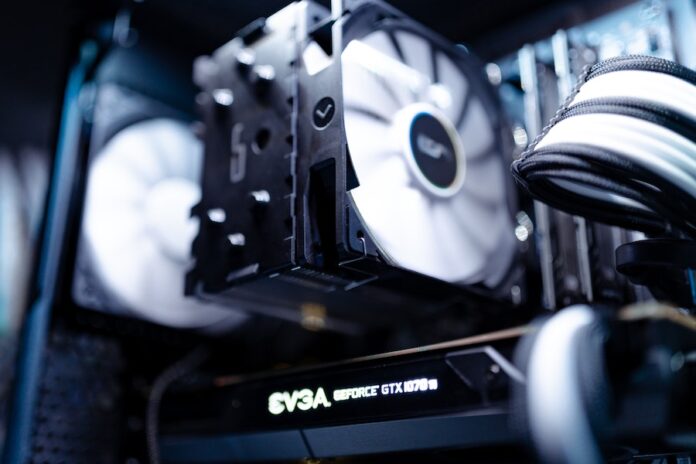In the ever-evolving world of computer hardware, where performance and components run hotter than ever, adequately cooling your CPU is paramount. At the heart of this cooling system lies the CPU fan, a critical component responsible for dissipating heat and ensuring your processor runs optimally. However, the correct orientation of this fan is a subject often shrouded in confusion for many PC enthusiasts. In this comprehensive guide, we will unravel the mystery surrounding the orientation of CPU fans, exploring the factors that influence their placement and helping you make informed decisions to keep your computer running excellently and efficiently.
Which Way Should Your CPU Fan Face?
The orientation of your CPU fan depends on your specific PC setup and cooling needs. In general, most CPU fans should face towards the rear or top of your case to ensure hot air is efficiently expelled. However, factors like your case’s airflow design, CPU cooler configuration, and motherboard layout can influence the best direction. For optimal results, consider your system’s unique requirements, ensuring that the CPU fan’s airflow complements your overall cooling strategy.
The Importance Of Proper CPU Cooling
Temperature Management: CPUs are at the core of any computing system, generating a substantial amount of heat while processing tasks. Left unchecked, this heat can accumulate rapidly, potentially reaching temperatures detrimental to the CPU’s health. Proper cooling solutions, such as CPU fans and heatsinks, dissipate this heat. By maintaining optimal temperatures, you ensure that your CPU operates efficiently and without the risk of overheating.
CPUs are designed to operate within specific temperature ranges. When a CPU exceeds its thermal limits, it often initiates a process called throttling, which reduces its clock speed to lower heat production. With proper cooling, your CPU might deliver the expected performance, particularly during demanding tasks like gaming, video editing, or running resource-intensive software.
High temperatures can significantly impact the lifespan of your CPU and other internal components. Prolonged exposure to excessive heat can lead to a phenomenon known as electromigration, which can damage the microscopic pathways within the CPU, causing it to degrade over time. Moreover, extreme temperatures can harm vital components like the motherboard, RAM, and graphics card. Proper cooling measures can mitigate these risks, ensuring your hardware lasts longer.
Overheating isn’t just a performance concern; it can also lead to system instability. When a CPU becomes too hot, it can cause system crashes, freezes, or data corruption. These issues can disrupt your work, lead to data loss, and potentially require costly repairs—adequate cooling safeguards against such instability providing a more reliable computing experience.
Inefficient cooling can force fans to run faster, creating more noise. This can be exceptionally bothersome in quiet environments or when you prefer a peaceful computing experience. Proper cooling solutions help maintain lower fan speeds, reducing the overall noise your system generates.
CPUs that run hotter often require more power to maintain their operations. This increased power consumption not only affects your electricity bill but also contributes to a higher carbon footprint. Proper cooling ensures your CPU operates efficiently, minimizing power consumption and environmental impact.
The role of the CPU fan in maintaining optimal temperatures
The CPU fan plays a pivotal role in maintaining optimal temperatures within your computer system. Its primary function is dissipating the heat generated by the central processing unit (CPU). Here’s a detailed look at the crucial role the CPU fan plays in temperature management:
Heat Dissipation: When your CPU operates, it generates a significant amount of heat due to the electrical currents flowing through its transistors. This heat, if not removed, can cause the CPU to overheat, leading to reduced performance and potential damage. The CPU fan is responsible for expelling this heat from the CPU and ensuring it operates within safe temperature limits.
Airflow Control: The CPU fan operates in conjunction with the CPU heatsink. The heatsink is a metal component with fins that help spread the heat evenly across its surface. The fan blows air across the heatsink’s fins, carrying away the heat. The design of the fan and heatsink is critical to efficient heat dissipation. An adequately designed combination can significantly enhance the cooling process.
Temperature Regulation: Many modern CPU fans have speed controls that adjust their RPM (revolutions per minute) based on the CPU’s temperature. When the CPU is under heavy load and generates more heat, the fan speeds up to increase airflow and cooling capacity. Conversely, during periods of lower CPU activity, the fan can slow down, reducing noise levels and power consumption.
Preventing Thermal Throttling: CPUs are designed to operate within specific temperature ranges. If the CPU exceeds these limits, it may initiate thermal throttling, which reduces its clock speed to lower heat generation. This results in decreased performance. The CPU fan’s role is critical in preventing thermal throttling by maintaining the CPU within safe temperature thresholds.
System Stability: Overheating can lead to system instability, crashes, and data corruption. The CPU fan, along with other cooling components in the system, helps maintain a stable operating environment. This is especially important in tasks that require uninterrupted performance, such as gaming, video editing, or scientific simulations.
Component Longevity: Keeping the CPU at optimal temperatures not only ensures its longevity but also contributes to the longevity of other components. Excessive heat can damage not only the CPU but also the motherboard, RAM, and nearby components—proper cooling safeguards against these risks, extending the life of your hardware.
Choosing the Right CPU Fan Orientation
Choosing the proper CPU fan orientation is a crucial step in ensuring effective cooling for your computer system. The optimal orientation depends on various factors, and making the right choice can significantly impact your system’s overall performance and temperature management. Here’s a detailed look at the considerations when selecting the appropriate CPU fan orientation:
System Requirements and Cooling Goals:
The first step in choosing the proper CPU fan orientation is to assess your system’s needs. Consider whether you’re running demanding tasks like gaming, video editing, or overclocking, as these activities generate more heat and may require a more aggressive cooling strategy. Understanding your cooling goals is crucial in determining the direction your CPU fan should face.
Case Layout and Airflow:
Your computer case’s layout and airflow design are pivotal in CPU fan orientation. Some cases are designed for positive pressure, where more intake fans are used, while others rely on negative pressure with more exhaust fans. Understanding your case’s airflow characteristics helps determine whether the CPU fan should be oriented for intake or exhaust.
CPU Socket Orientation:
The CPU socket’s orientation on your motherboard can affect the ideal fan direction. In most cases, the CPU fan should face towards the rear or top of the case to ensure hot air is efficiently expelled. However, some motherboards may have socket orientations that require different cooling solutions, so it’s essential to check your specific motherboard’s layout.
Heatsink Design:
The type and design of your CPU heatsink can influence the fan’s orientation. Some heatsinks are designed with a push-pull configuration, where two fans move air through the heatsink. Others are designed for a single fan in a specific orientation. Ensure your CPU fan choice aligns with your heatsink’s design for optimal cooling efficiency.
Compatibility with the Motherboard:
Different motherboards may have varying layouts and clearances around the CPU socket. Ensure your chosen CPU fan orientation is compatible with your motherboard without interfering with components like RAM, graphics cards, or chipset heatsinks.
Monitoring and Adjustments:
Once you’ve selected an orientation, regularly monitor your CPU temperatures using software utilities or hardware monitoring tools. Adjust the fan’s speed settings in your motherboard’s BIOS or through software to find the right balance between cooling performance and noise levels. This fine-tuning ensures your CPU remains within safe temperature limits while minimizing unnecessary fan noise.
Tips For Proper CPU Fan Installation
Proper CPU fan installation is crucial for effective cooling and the overall health of your computer. Here are some essential tips to ensure a successful CPU fan installation:
- Before you start, carefully read the user manual that comes with your CPU cooler and motherboard. These documents provide instructions and diagrams tailored to your components, helping you avoid mistakes.
- To prevent damage to sensitive components, discharge any static electricity by touching a grounded metal object before handling your CPU cooler or motherboard. Additionally, consider using an anti-static wrist strap during installation.
- Ensure your workspace is clean and free of dust and debris. A clean environment reduces the risk of contaminants interfering with the thermal paste or inside your CPU cooler.
- Proper thermal paste application is crucial for efficient heat transfer between the CPU and the cooler. Apply a small, pea-sized amount (or follow the manufacturer’s recommendations) at the center of the CPU. The pressure from installing the cooler will spread the paste evenly.
- CPU coolers have various mounting mechanisms, such as push pins, clips, or screws. Make sure you understand how your cooler is secured to the motherboard and follow the provided instructions precisely.
- Ensure that the CPU fan is oriented correctly for optimal airflow. In most cases, the fan should direct air toward the rear or top of the case, expelling hot air away from the CPU. Check your motherboard’s documentation for guidance on fan header placement.
Bottom Line
Should I use air cooling or liquid cooling for my CPU?
The choice between air and liquid cooling depends on your needs and preferences. Air cooling is more straightforward and cost-effective, while liquid cooling often provides better thermal performance but is more complex to install and maintain.
How do I determine the right CPU fan size for my case?
Check your computer case’s specifications for the maximum CPU cooler height and width it can accommodate. Choose a CPU fan within these dimensions to ensure it fits properly.
Can I use multiple CPU fans for better cooling performance?
Yes, you can use multiple CPU fans in a push-pull configuration to enhance cooling performance. This involves one fan pushing air through the CPU heatsink and another pulling air from the other side. However, be sure your case and motherboard support this setup.
How often should I clean my CPU fan and heatsink?
The frequency of cleaning depends on your environment, but it’s a good practice to clean your CPU fan and heatsink at least once every few months. Dust can accumulate and reduce cooling efficiency over time.





